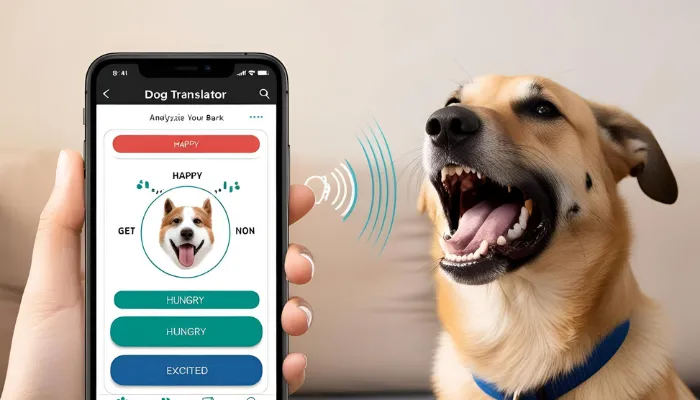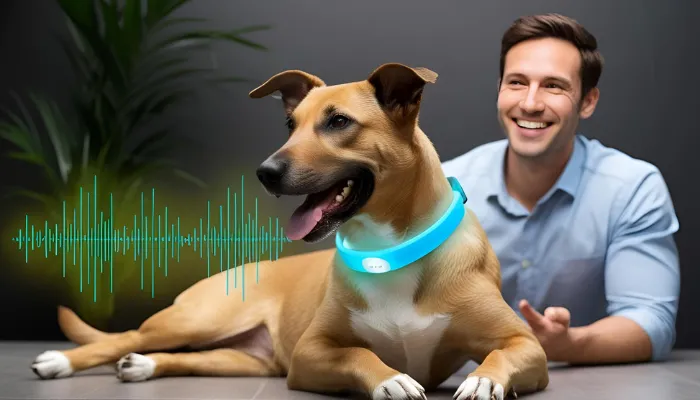English to dog translator—have you ever asked yourself if such a program would actually be effective? For most pet owners, the dream is simple – to be able to have a dialogue with their four-legged buddy, to know what he barks, and respond in such a manner that the pet understands. It does sound like a sci-fi thing, but is the dog translator really possible?
With the growth of technology, it is now possible to chat with dogs using an English to dog bark translator, as there are apps and devices that claim to help do so. But do these tools actually work, or are they just a gimmick? In this post, we will look at the functioning of these translators, their scientific relevance, and what other methods can be taken to enhance interaction with man’s best friend.

English to Dog Translator: How Does It Work?
The basic idea behind an English to dog translator is simple: it translates human speech into a form dogs can understand and vice versa. These devices or apps claim to analyze dog barks, whines, and growls, then convert them into human-readable meanings. Some even allow you to speak into the device, which then translates your words into sounds that resemble dog communication.
Science Behind Dog Communication
Dogs communicate using a combination of:
- Barks – Indicating excitement, warning, or distress.
- Whines – Often a sign of neediness or discomfort.
- Growls – Used as a warning or a playful expression.
- Body language – Tail wagging, ear positions, and posture tell a lot about their mood.
A true English to dog bark translator would need to accurately analyze these vocalizations and gestures to determine meaning. But how accurate are the current models?
Types of Dog Translators
There are three main types of English to dog translators available:
- Mobile Apps – These claim to analyze your dog’s barks and translate them into words or phrases.
- Wearable Devices – Small gadgets that attach to your dog’s collar and provide real-time analysis.
- Speaker-Based Translators – Devices that allow you to speak and then convert your words into “dog language” sounds.
While these tools offer an exciting glimpse into canine communication, understanding your dog’s body language and vocal cues remains the most reliable way to connect with them.
Can Technology Really Decode Dog Language?
While the concept of an English to dog translator is fascinating, most experts agree that truly translating dog barks into human language is extremely challenging. Here’s why:
- Dogs lack a complex spoken language – Unlike humans, dogs don’t have a structured language with grammar and vocabulary.
- Context is key – The same bark could mean different things in different situations.
- Individual dog differences – Each dog has a unique way of barking and communicating.
Even the best English to dog bark translator apps struggle to differentiate between playful barking and aggressive barking without context.

Popular English to Dog Translator Apps & Gadgets
Several products claim to bridge the communication gap between dogs and their owners. But do they really work like dog translator apps? Here’s a look at some of the most popular ones.
| Translator | Type | Features | Accuracy |
|---|---|---|---|
| Dog Translator App | Mobile App | Translates barks into text | Low |
| BowLingual | Wearable Device | Analyzes dog emotions | Medium |
| Petpuls | Collar Device | AI-powered bark analysis | Medium-High |
| TalkToDog | Speaker-Based | Converts human words into dog sounds | Low |
While these tools can be fun and insightful, they should be used as a supplement to, not a replacement for, understanding your dog’s natural communication.

Real-World Examples of English to Dog Translators
The concept of an English to dog translator may seem strange, but several applications and devices have been designed with the intent of fostering communication between humans and dogs. Here are some of the most well-known examples:
1. BowLingual – The First Dog Translator
- The dog translator known as BowLingual was developed in Japan, making it one of the first successful attempts to get a dog to speak English.
- It divided barking into 6 different categories based on emotion using sound analysis, including happy, sad, frustrated, on guard, assertive and needy.
- There was much debate about the accuracy of this device but needless to say, it was an interesting gadget.
2. No More Woof – EEG Based Dog Communication
- The Nordic Society of Invention and Discovery developed this device as a prototype.
- Instead of bark analysis, the device translated patterns of brain activity into phrases using EEG, saying things like “I’m tired” or “I’m excited.”
- This project faced numerous complaints and was never fully developed.
3. PetPuls – AI Powered Dog Emotion Analyzer
- PetPuls has created a smart dog collar that, through AI, unlocks the ability to analyze a dog’s barks, classifying them into five different emotions.
- The company claims an 80% accuracy rate in identifying a dog’s emotional state.
- It connects to a phone application which gives owners insight into their pet’s moods and well-being.
4. Dog Translator Apps – Fun or Functional?
- There are a number of applications on the market, including Human to Dog Translator and “Dog Bark Translator,” which state they can translate human speech into dog language.
- Most of these applications are purely for fun, but some dog owners claim their dogs react to some of the sounds.
- Some scientists believe this app does not translate appropriately because team lacks contextual information.
What Do Users Say?
While some pet owners use these devices for fun, others think they can shed some light on thier dog’s feelings. Above all, specialists contend that dog emotions are deciphered through their body language, hence no technology can substitute for that.
These English to dog translator devices might not get it all right, but they certainly present a promising advancement into what the future of interaction between humans and dogs may hold.
What Do Scientists Say About Dog Translation?
Several studies have explored whether dog barks can be translated, including efforts to develop an English to dog bark translator to interpret their meanings.
- Dogs have about 10 distinct types of vocalizations used for different situations.
- AI-powered tools have shown some potential in identifying a dog’s emotions but not exact thoughts.
- Context and tone matter more than actual words when dogs communicate with humans.
While current English to dog translator tools may help identify emotional states, they are far from true translation devices.
Can Humans Learn to Speak Dog?
It’s not just about being able to talk with dogs; an owner must understand how to ‘speak’ with their furry friend. While the English to dog translator concept aims to bridge the communication gap, the canine world does not possess fully formed sentences like humans do. However, there is a level of understanding that can be achieved.
Ways Humans Can Speak Dog:
- Using Tone & Pitch: Dogs are responsive to feelings rather than words. Maintaining an upbeat tone encourages excitement, while a commanding tone signifies authority.
- Mimicking Sounds: Short and high tone sounds signal playfulness, while lower growl like sounds indicate seriousness.
- Body Language Adjustments: By crouching, one makes himself smaller which is a show of friendliness, while standing tall indicates authority.
- Facial Expressions: Because dogs are able to understand human emotions, smiling goes a long way in fostering good bonding experiences.
These observations of dogs using cower language with one another can be incorporated into how we humans relate with them, thus improving the interactions we have with them.
With effort, we can learn to speak and understand many of our dog’s body movements and gestures, enabling us to form a deeper emotional bond with them.
How to Communicate With Your Dog Effectively?
Working with your dog’s methods of communication is just as important as the words used. Using an English to dog translator may seem helpful, but truly understanding your pet goes beyond technology. Improving your interaction and relationship with your furry friend can be done as follows:
- Use Clear and Consistent Commands
- Use single commands such as “stay”, “sit”, and “come”.
- Always use the same command to prevent misunderstandings.
- Pay Attention to Tone of Voice
- If the goal is excitement, the command should be given in a cheerful manner.
- Use a firm voice that is also calm in order to be in control.
- Understand and Respond to Body Language
- Observe their tail, ears, and posture for their mood.
- Avoid staring at your pup because it can be intimidating.
- Reinforce Good Behavior with Positive Reinforcement
- Give treats, praise, or even playtime when commands are followed.
- Make sure you are consistent and patient if you want them to learn long term.
- Use Hand Signals Alongside Verbal Commands
- Dogs respond best to hand movements because they are visual learners.
- Use hand movements alongside the command for clarity.
- Respect Their Natural Communication Style
- Understand the meaning behind different barks, growls, and whines.
- Respond to gain their trust while building understanding.
Realizing these methods will allow both communication and relationship to be enhanced. Most importantly, sticking to these methods will further strengthen the bond towards your furry companion.
Conclusion
An English to dog translator would be great for pet lovers, but communication in today’s world is not perfected. Even with some English to dog bark translator apps and devices, they do help capture a dog’s feelings, but they don’t do it accurately.
The simplest way to engage with your fluffy companion is to know and appreciate their body movements, sounds, and the caretaking relationship you have with them. While we may not have a perfect translator yet, our pets already understand us better than we think!
